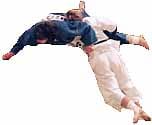by Neil Ohlenkamp Judo competition rules have evolved gradually over the past century, but especially since the formation of the International Judo Federation in 1951. The earliest recorded rules dealt with individual matches, and it was only later when Judo tournaments were organized with large numbers of competitors that methods had to be created to determine who was the winner among a group of people. Some tournaments are team tournaments where competitors from one team fight those from another, and the team with the best record wins. The following text only describes some of the more common individual, not team, tournament systems. Traditionally Judo competitions were organized using the “winner stays up” or Kohaku shiai method. In this method contestants were lined up by size, or sometimes rank and experience were also considered, and the smallest two competitors in a division would fight. Then the winner would stay on the mat to fight the next biggest competitor. The winner of each match would again stay up until losing. The largest person, if he won, would be permitted to fight back down the line a limited number of matches. The person with the most wins at the end would be declared the winner. Another common method is the round robin. In this method every competitor fights every other competitor. The one with the most wins at the end gets first place. This is generally only used when the number of competitors in a division is very small. The modern methods used for organizing various types of Judo competitions are generally called pool systems. Within each weight division each competitor is placed in a pool that determines who they fight first. This is usually done by a random draw. The first modern method is the strict double elimination. In this method each competitor continues to fight until they have lost twice. The last three people to be eliminated are the place winners, with the first place winner having 0 or 1 loss. This often results in the top three competitors having multiple fights against each other. The second, more common, method is the modified double elimination system. Like the strict double elimination system, competitors are moved to a loser’s pool after they lose once and eliminated after they lose twice. However the winner of the winner’s pool will always get first place. The loser in the finals will fight the winner of the loser’s pool to determine second and third place. The first place winner will always have no losses, second place will have only one loss, and third place will have two losses. Finally is the elimination system with double repechage, or repechage system, used in all major national and international tournaments including the Olympic Games. The contestants are divided into two tables by means of a draw, and an elimination system is used to produce two finalists. Only contestants defeated by the two finalists take part in the loser’s pool, or repechage, of their respective table. Their final contest will be against the loser of the final of each receptive other table. In this system the first place winner has no losses, the second place winner has one loss to the first place winner in the finals, and there are two third place winners who have only one loss (to the first or second place winner) and have won their repechage. See this example of an Olympic pool sheet. “I only train on days ending in a Y.” –Neil Ohlenkamp “The serious Judo exponent trains every day.” |
| |


